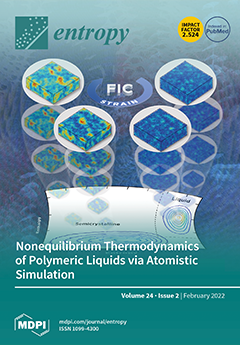As computational fluid dynamics (CFD) advances, entropy generation minimization based on CFD becomes attractive for optimizing complex heat-transfer systems. This optimization depends on the accuracy of CFD results, such that accurate turbulence models, such as elliptic relaxation or elliptic blending turbulence models, become
[...] Read more.
As computational fluid dynamics (CFD) advances, entropy generation minimization based on CFD becomes attractive for optimizing complex heat-transfer systems. This optimization depends on the accuracy of CFD results, such that accurate turbulence models, such as elliptic relaxation or elliptic blending turbulence models, become important. The performance of a previously developed elliptic blending turbulence model (the
model) to predict the rate of entropy generation in the fully developed turbulent circular tube flow with constant heat flux was studied to provide some guidelines for using this class of turbulence model to calculate entropy generation in complex systems. The flow and temperature fields were simulated by using a CFD package, and then the rate of entropy generation was calculated in post-processing. The analytical correlations and results of two popular turbulence models (the realizable
k–
ε and the shear stress transport (SST)
k–
ω models) were used as references to demonstrate the accuracy of the
model. The findings indicate that the turbulent Prandtl number (Pr
t) influences the entropy generation rate due to heat-transfer irreversibility. Pr
t = 0.85 produces the best results for the
model. For the realizable
k–
ε and SST
k–
ω models, Pr
t = 0.85 and Pr
t = 0.92 produce the best results, respectively. For the realizable
k–
ε and the SST
k–
ω models, the two methods used to predict the rate of entropy generation due to friction irreversibility produce the same results. However, for the
model, the rates of entropy generation due to friction irreversibility predicted by the two methods are different. The difference at a Reynolds number of 100,000 is about 14%. The method that incorporates the effective turbulent viscosity should be used to predict the rate of entropy generation due to friction irreversibility for the
model. Furthermore, when the temperature in the flow field changes dramatically, the temperature-dependent fluid properties must be considered.
Full article






